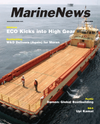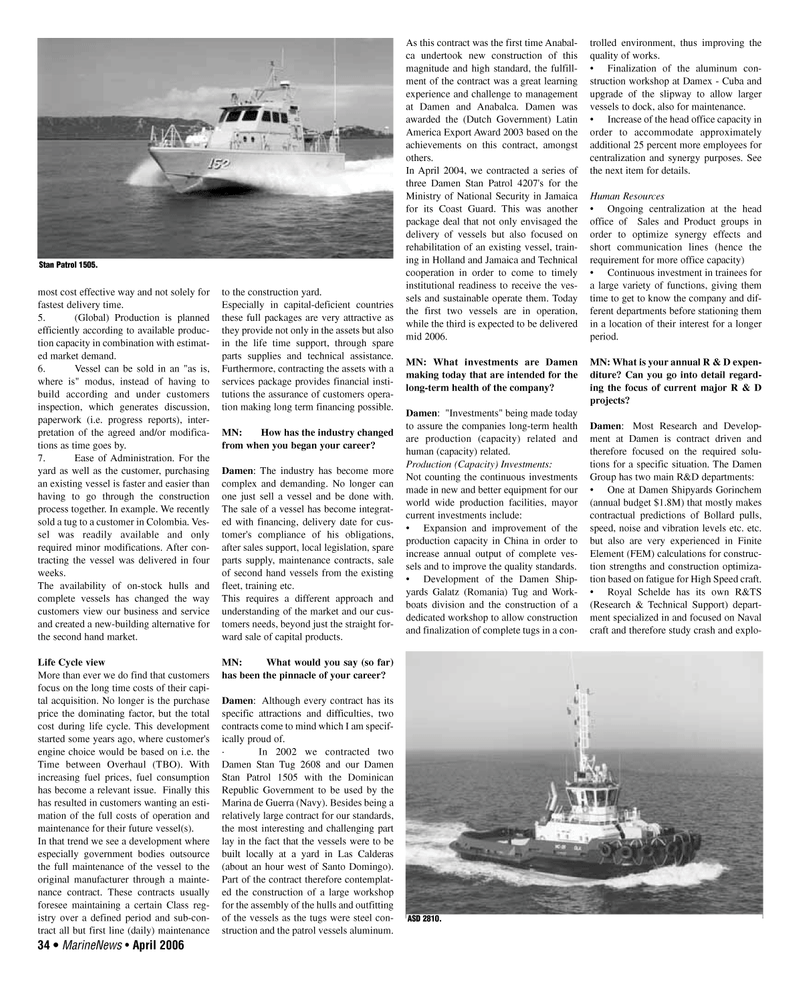
Page 34: of Marine News Magazine (April 2006)
Offshore Support
Read this page in Pdf, Flash or Html5 edition of April 2006 Marine News Magazine
most cost effective way and not solely for fastest delivery time. 5. (Global) Production is planned efficiently according to available produc- tion capacity in combination with estimat- ed market demand. 6. Vessel can be sold in an "as is, where is" modus, instead of having to build according and under customers inspection, which generates discussion, paperwork (i.e. progress reports), inter- pretation of the agreed and/or modifica- tions as time goes by. 7. Ease of Administration. For the yard as well as the customer, purchasing an existing vessel is faster and easier than having to go through the construction process together. In example. We recently sold a tug to a customer in Colombia. Ves- sel was readily available and only required minor modifications. After con- tracting the vessel was delivered in four weeks.
The availability of on-stock hulls and complete vessels has changed the way customers view our business and service and created a new-building alternative for the second hand market.
Life Cycle view
More than ever we do find that customers focus on the long time costs of their capi- tal acquisition. No longer is the purchase price the dominating factor, but the total cost during life cycle. This development started some years ago, where customer's engine choice would be based on i.e. the
Time between Overhaul (TBO). With increasing fuel prices, fuel consumption has become a relevant issue. Finally this has resulted in customers wanting an esti- mation of the full costs of operation and maintenance for their future vessel(s).
In that trend we see a development where especially government bodies outsource the full maintenance of the vessel to the original manufacturer through a mainte- nance contract. These contracts usually foresee maintaining a certain Class reg- istry over a defined period and sub-con- tract all but first line (daily) maintenance to the construction yard.
Especially in capital-deficient countries these full packages are very attractive as they provide not only in the assets but also in the life time support, through spare parts supplies and technical assistance.
Furthermore, contracting the assets with a services package provides financial insti- tutions the assurance of customers opera- tion making long term financing possible.
MN: How has the industry changed from when you began your career?
Damen: The industry has become more complex and demanding. No longer can one just sell a vessel and be done with.
The sale of a vessel has become integrat- ed with financing, delivery date for cus- tomer's compliance of his obligations, after sales support, local legislation, spare parts supply, maintenance contracts, sale of second hand vessels from the existing fleet, training etc.
This requires a different approach and understanding of the market and our cus- tomers needs, beyond just the straight for- ward sale of capital products.
MN: What would you say (so far) has been the pinnacle of your career?
Damen: Although every contract has its specific attractions and difficulties, two contracts come to mind which I am specif- ically proud of. · In 2002 we contracted two
Damen Stan Tug 2608 and our Damen
Stan Patrol 1505 with the Dominican
Republic Government to be used by the
Marina de Guerra (Navy). Besides being a relatively large contract for our standards, the most interesting and challenging part lay in the fact that the vessels were to be built locally at a yard in Las Calderas (about an hour west of Santo Domingo).
Part of the contract therefore contemplat- ed the construction of a large workshop for the assembly of the hulls and outfitting of the vessels as the tugs were steel con- struction and the patrol vessels aluminum.
As this contract was the first time Anabal- ca undertook new construction of this magnitude and high standard, the fulfill- ment of the contract was a great learning experience and challenge to management at Damen and Anabalca. Damen was awarded the (Dutch Government) Latin
America Export Award 2003 based on the achievements on this contract, amongst others.
In April 2004, we contracted a series of three Damen Stan Patrol 4207's for the
Ministry of National Security in Jamaica for its Coast Guard. This was another package deal that not only envisaged the delivery of vessels but also focused on rehabilitation of an existing vessel, train- ing in Holland and Jamaica and Technical cooperation in order to come to timely institutional readiness to receive the ves- sels and sustainable operate them. Today the first two vessels are in operation, while the third is expected to be delivered mid 2006.
MN: What investments are Damen making today that are intended for the long-term health of the company?
Damen: "Investments" being made today to assure the companies long-term health are production (capacity) related and human (capacity) related.
Production (Capacity) Investments:
Not counting the continuous investments made in new and better equipment for our world wide production facilities, mayor current investments include: Expansion and improvement of the production capacity in China in order to increase annual output of complete ves- sels and to improve the quality standards. Development of the Damen Ship- yards Galatz (Romania) Tug and Work- boats division and the construction of a dedicated workshop to allow construction and finalization of complete tugs in a con- trolled environment, thus improving the quality of works. Finalization of the aluminum con- struction workshop at Damex - Cuba and upgrade of the slipway to allow larger vessels to dock, also for maintenance. Increase of the head office capacity in order to accommodate approximately additional 25 percent more employees for centralization and synergy purposes. See the next item for details.
Human Resources Ongoing centralization at the head office of Sales and Product groups in order to optimize synergy effects and short communication lines (hence the requirement for more office capacity) Continuous investment in trainees for a large variety of functions, giving them time to get to know the company and dif- ferent departments before stationing them in a location of their interest for a longer period.
MN: What is your annual R & D expen- diture? Can you go into detail regard- ing the focus of current major R & D projects?
Damen: Most Research and Develop- ment at Damen is contract driven and therefore focused on the required solu- tions for a specific situation. The Damen
Group has two main R&D departments: One at Damen Shipyards Gorinchem (annual budget $1.8M) that mostly makes contractual predictions of Bollard pulls, speed, noise and vibration levels etc. etc. but also are very experienced in Finite
Element (FEM) calculations for construc- tion strengths and construction optimiza- tion based on fatigue for High Speed craft. Royal Schelde has its own R&TS (Research & Technical Support) depart- ment specialized in and focused on Naval craft and therefore study crash and explo- 34 • MarineNews • April 2006
Stan Patrol 1505.
ASD 2810.
APRIL MN2006 5(33-40).qxd 4/7/2006 3:11 PM Page 34

 33
33

 35
35
